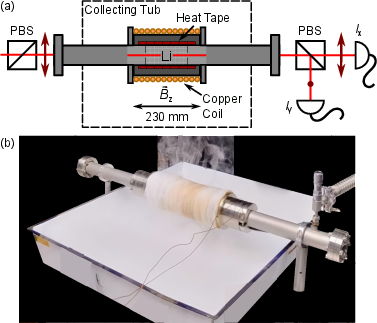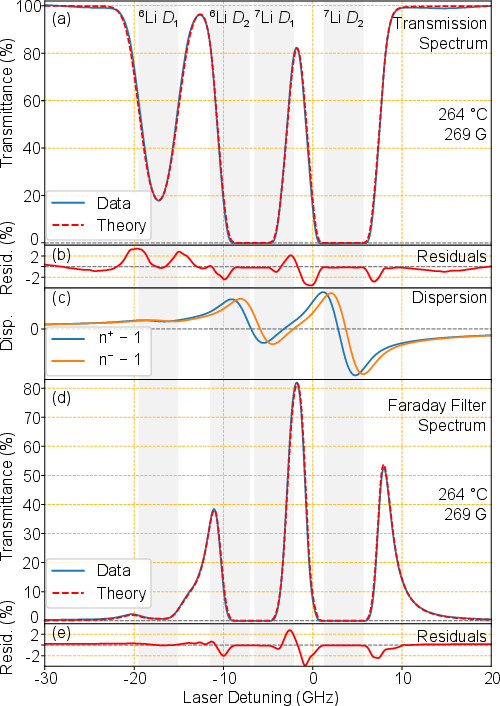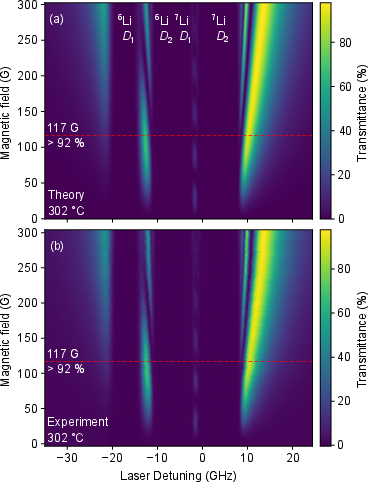- The paper presents an experimental and theoretical demonstration of an ultra-narrowband lithium Faraday filter, achieving 82% peak transmission and a 5.32 GHz equivalent noise bandwidth.
- It extends the ElecSus library to accurately model lithium’s closely spaced D-line transitions, incorporating isotope effects, Doppler, and pressure broadening phenomena.
- The study optimizes key parameters—264°C vapor temperature and 269 G magnetic field—to ensure effective narrowband filtering for high-fidelity optical detection in quantum optics.
Lithium Faraday Filter: Experimental Realization and Theoretical Modeling
Introduction
The paper presents a comprehensive paper of an ultra-narrowband Faraday filter based on hot lithium vapor, operating near the 671 nm D-line transitions. The work addresses both experimental and theoretical aspects, including the design and optimization of the filter, the challenges posed by lithium's low vapor pressure and closely spaced D-line transitions, and the extension of the ElecSus Python library to enable accurate modeling of lithium's atomic susceptibilities. The filter achieves high transmission and narrow bandwidth, making it suitable for high-fidelity optical detection in quantum optics and related fields.
Experimental Design and Implementation
The experimental setup utilizes a custom-built heat pipe oven to maintain lithium vapor at temperatures exceeding 260 ∘C, necessary due to lithium's low vapor pressure. The lithium sample is housed in a steel cartridge, surrounded by a solenoid to generate a longitudinal magnetic field up to 300 G. The probe light is derived from a Ti:Sa ring laser, stabilized and scanned across the lithium D-line spectrum. Polarizing beamsplitters before and after the vapor cell enable measurement of the rotated and unrotated light components, facilitating reconstruction of the transmission and Faraday rotation spectra.

Figure 1: Schematic of the lithium Faraday filter setup, showing the heat pipe, solenoid, lithium cartridge, and optical detection scheme.
The design addresses several technical challenges: maintaining a stable high temperature, preventing lithium oxidation via argon flushing and evacuation, and managing thermal effects on the solenoid's resistance. The use of a nickel mesh enhances magnetic field strength and retains lithium within the cartridge. Cooling water is circulated to prevent overheating of the solenoid.
Theoretical Modeling and ElecSus Extension
Lithium's D1 and D2 transitions are separated by only 10 GHz, leading to significant spectral overlap, especially under Doppler broadening at high temperatures. The natural abundance of 6Li (7.58%) and 7Li further complicates the spectral features. The standard ElecSus library, designed for alkali metals with well-separated D-lines, was insufficient for accurate modeling. The authors extended ElecSus to simultaneously compute susceptibilities for both transitions and isotopes, incorporating power broadening and saturation effects (s=I/Isat=0.26).
This extension enables fitting of experimental spectra with residuals below ±4% at steep edges, validating the theoretical approach. The model accounts for Zeeman splitting, Doppler and pressure broadening, and the effective optical path length, which is challenging to determine due to temperature gradients and the absence of sharp cell boundaries.
Simulations and experiments identify optimal operating conditions: 264 ∘C vapor temperature, 269 G magnetic field, and 150 mm optical path length. Under these conditions, the filter achieves a peak transmission of approximately 82% near zero detuning of the 7Li D2 line, with an equivalent noise bandwidth (ENBW) of 5.32 GHz and a figure of merit (FOM) of 0.154 GHz−1. These metrics are competitive with Faraday filters based on other alkali metals, despite lithium's higher Doppler broadening.

Figure 2: Transmission and Faraday filter spectra for lithium vapor, showing experimental and theoretical agreement, residuals, and dispersion.
Further measurements across varying magnetic fields reveal that transmittance can exceed 90% (e.g., 92% at 117 G), but with a trade-off in ENBW and FOM. The optimal filter performance does not coincide with the point of anomalous dispersion but rather lies within the spectral wings, consistent with recent findings for other alkali-based Faraday filters.

Figure 3: Density plots of Faraday filter transmittance versus magnetic field, comparing simulated and experimental data; peak transmission and bandwidth are highlighted.
The filter exhibits robust performance despite substantial Doppler broadening (up to 505 ∘C equivalent temperature) and pressure broadening from buffer gas, which was not explicitly modeled. The effective rotation of the polarized field is governed by the relation θF=λπ(χ+′−χ−′)L, with L and T strongly correlated due to the experimental geometry.
Practical Implications and Limitations
The lithium Faraday filter enables narrowband optical filtering at 671 nm, enhancing signal-to-noise ratios for quantum state readout and other precision measurements. The high operating temperature and associated engineering challenges (thermal management, cell length determination, temperature gradients) are significant limitations for practical deployment. The extended ElecSus library, now supporting lithium, is publicly available and facilitates further research and optimization.
The filter's performance metrics (transmission, ENBW, FOM) are suitable for applications requiring GHz-scale bandwidths and high transmission, such as quantum optics, atomic spectroscopy, and laser stabilization. The approach is generalizable to other atomic species with closely spaced transitions, provided appropriate modeling of overlapping lines and broadening mechanisms.
Future Directions
Potential future developments include improved thermal management and cell design to reduce temperature gradients and enable more precise control of vapor density and path length. Incorporating buffer gas effects and pressure broadening into the theoretical model would further enhance accuracy. The filter's application in quantum information processing, magnetometry, and high-resolution spectroscopy is promising, especially as lithium-based systems become more prevalent in cold atom and quantum simulation experiments.
The extension of ElecSus to lithium opens avenues for systematic studies of Faraday filters across a broader range of atomic species and operating regimes. Further optimization of filter parameters (magnetic field, temperature, cell geometry) could yield even narrower bandwidths and higher transmission, advancing the state-of-the-art in atomic optical filtering.
Conclusion
This work demonstrates the realization and modeling of a high-performance lithium Faraday filter, overcoming the challenges posed by lithium's physical properties and closely spaced D-line transitions. The experimental results, supported by an extended theoretical framework, establish lithium as a viable medium for ultra-narrowband optical filtering. The filter's capabilities are relevant for precision optical detection and quantum optics, with the extended ElecSus library providing a valuable tool for future research and development.


